| Columns Retired Columns & Blogs |
Audio Physic Scorpio loudspeaker Measurements
Sidebar 3: Measurements
The Audio Physic Scorpio has a high specified sensitivity of 91dB/W/m. However, measured on its tweeter axis without the grille, the speaker appeared to have just above average voltage sensitivity, at an estimated 88.5dB(B)/2.83V/m. Its impedance (fig.1) stays between 4 and 6 ohms over most of the audioband, with a minimum value of 3.6 ohms at 93.5Hz. There is also a combination of 5.2 ohms and a –41° electrical phase angle at 78Hz, which might be taxing for optimistically specified power amplifiers, given that many kinds of music tend to have a lot of energy at this frequency.
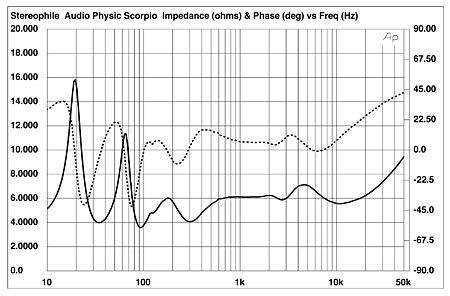
Fig.1 Audio Physic Scorpio, electrical impedance (solid) and phase (dashed). (2 ohms/vertical div.)
A discontinuity is visible in the impedance traces at 125Hz, suggesting some kind of resonance. However, while a cumulative spectral-decay plot (calculated from the output of an accelerometer fastened to the front baffle and level with the center of the side-mounted woofers) revealed a major vibrational mode at 266Hz (fig.2), the other panels were relatively well-behaved and nothing was evident at 125Hz.
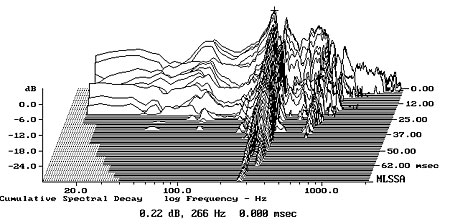
Fig.2 Audio Physic Scorpio, cumulative spectral-decay plot calculated from the output of an accelerometer fastened to the cabinet's front baffle level with the woofers (MLS driving voltage to speaker, 7.55V; measurement bandwidth, 2kHz).
The saddle centered between 30Hz and 40Hz in the impedance-magnitude trace suggests that the rear- and bottom-facing ports are tuned to a low frequency. The green trace in fig.3 shows the summed acoustic output of the ports, measured in the nearfield and scaled in the proportion of the square root of the total radiating area compared with those of the woofers and the midrange units. A little down in level, it doesn't fully extend the Scorpio's low-frequency response, though this graph does not take into account the fact that the bottom port's output will be reinforced by the floor. The ports will also relieve the woofers of high midbass excursions. The trace also has some resonant peaks evident in the midrange, though these are well down in level, and there is a small peak present at 125Hz.
The minimum-motion point of the woofers' summed outputs (fig.3, red trace) occurs at a fairly low 38Hz, with a response rise above that frequency peaking between 80Hz and 100Hz. Most of this peak will be due to the exaggerating effect of the nearfield measurement, which assumes a 2pi (half-space) acoustic environment. Even so, the Scorpio's upper bass is a little rich in absolute terms, its mid-bass shelved-down. A suckout is evident at 300Hz in the woofers' response, with only a gentle rollout evident above that frequency.
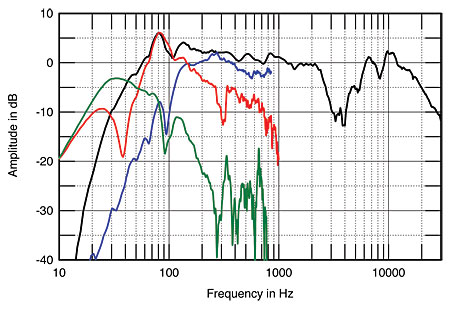
Fig.3 Audio Physic Scorpio, anechoic response on tweeter axis at 50", averaged across 30° horizontal window and corrected for microphone response, with the nearfield responses of the midrange units (blue), woofers (red), port (green), and their complex sum (black).
The midrange units differ a little, in that the lower driver gently rolls off above 450Hz while the upper driver continues upward in frequency to cross over to the tweeter at a measured 2.4kHz. The sum of the nearfield midrange responses (fig.3, blue trace) crosses over to the woofers at 150Hz, with an approximate second-order rollout broken by a notch at 93Hz. Higher in frequency, the upper midrange is impressively flat on the tweeter axis, but with an alarming suckout in the presence region. This lack of energy—presumably due to destructive interference between the tweeter and midrange-unit outputs on this axis, which is 41" from the floor—would help explain why the Scorpio's measured sensitivity was lower than the specified figure.
The depth of this suckout was very critical regarding the measurement axis. Moving the microphone 1" higher reduced its depth. How the Scorpio's anechoic response changes in the vertical plane is shown in fig.4, with the tweeter-axis response subtracted from each trace so that just the changes in response are plotted. The crossover-region suckout starts to fill in as you move your ears above the tweeter axis, but deepens below that axis—which is perverse, considering that the average seated person's ear height is 36". But the treble response isn't very flat even above the tweeter axis, as can be seen in the response averaged across a 30° horizontal window 45" from the floor (fig.5). While the suckout is less severe, the top two octaves are elevated on this axis, which is why Mikey found the speaker to sound bright when he stood up.
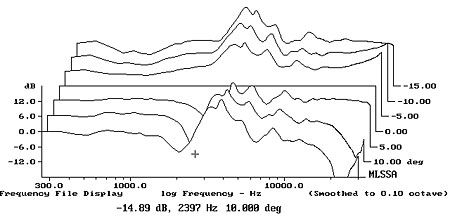
Fig.4 Audio Physic Scorpio, vertical response family at 50", normalized to response on tweeter axis, from back to front: differences in response 15–5° above axis, reference response, differences in response 5–15° below axis.
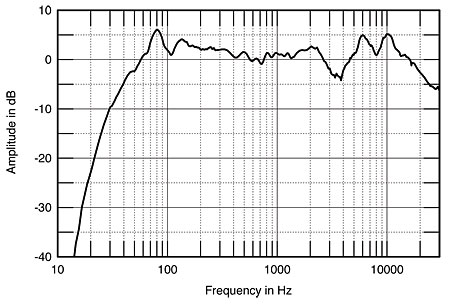
Fig.5 Audio Physic Scorpio, anechoic response on axis 43" from the floor at 50", averaged across 30° horizontal window and corrected for microphone response, with the complex sum of the nearfield drive-unit responses.
What matters to the listener, of course, is the sound in the room. Fig.6 shows the spatially averaged response produced by the pair of Scorpios, measured at the ear position in Michael Fremer's listening room. Only a mere trace of the presence-region suckout can be seen, and other than a small peak in the region where the woofers had their nearfield peak and a slight lack of energy in the 125Hz band, the Audio Physics' room response is superbly flat from 100Hz to 10kHz. Above that frequency, the in-room energy drops due to the tweeter's limited dispersion.
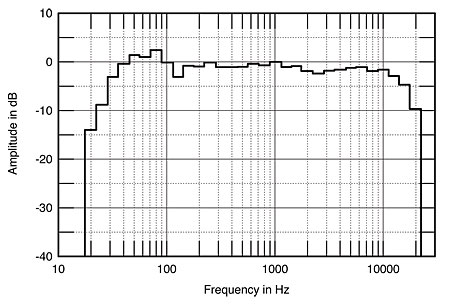
Fig.6 Audio Physic Scorpio, spatially averaged, 1/3-octave response in MF's listening room.
The plots of the Scorpio's dispersion in the lateral plane—fig.7 shows the actual responses plotted from 90° on one side of the tweeter axis to 90° on the other, while fig.8 shows just the differences—reveal that the suckout in the presence region is confined to a region 15° either side of the primary axis. At more extreme angles the speaker's output becomes quite flat, other than the usual rolloff in the top octave due to the dome tweeter's increasing directivity in this region. So while the direct sound of the Scorpio experienced by a listener sitting with his ears on or just below the tweeter axis will lack presence, the room's reverberant field will have a full measure of energy in this region. The larger or more reverberant the room and the farther away the listener sits, the more the Scorpio's treble will sound neutrally balanced. Conversely, the smaller and deader the room, the more the speaker will sound distant, lifeless, and hollow. But these plots do suggest that Scorpio owners experiment with toe-in to get a satisfactory tonal balance.

Fig.7 Audio Physic Scorpio, lateral response family at 50", from back to front: responses 90–5° off axis, tweeter-axis response, responses 5–90° off axis.
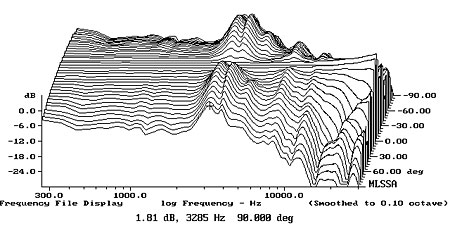
Fig.8 Audio Physic Scorpio, lateral response family at 50", normalized to response on tweeter axis, from back to front: differences in response 90–5° off axis, reference response, differences in response 5–90° off axis.
In the time domain, the Scorpio's step response on the tweeter axis (fig.9) indicates that the tweeter and midrange units are connected in the same, positive acoustic polarity. However, the continuation of the tweeter's step is in opposite polarity to the onset of the midrange units' step, hence the cancellation of their outputs on this axis in the region where they overlap. The woofers are connected in negative acoustic polarity, which, in conjunction with their physical setback, means that their outputs coincide with the negative-going overshoot of the midrange units, correlating with the good frequency-domain integration of those units' outputs. The Audio Physic's waterfall plot on the tweeter axis (fig.10) is disturbed, of course, by the presence-region suckout, but is generally clean, though a low-level mode can be seen at 3.8kHz.

Fig.9 Audio Physic Scorpio, step response on tweeter axis at 50" (5ms time window, 30kHz bandwidth).
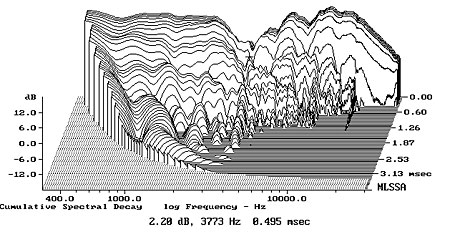
Fig.10 Audio Physic Scorpio, cumulative spectral-decay plot at 50" (0.15ms risetime).
When I examine a loudspeaker like the Audio Physic Scorpio, I am compelled to wonder why the designer chose the specific drive-unit polarities that he did. Yes, the spatially averaged response in MF's room was superbly flat, but a conventional arrangement of drive-unit polarities would also have measured flat in-room, and would have made the speaker less fussy about setup and listening axis.—John Atkinson
- Log in or register to post comments




































